#elk island national park
Text


Mountain coyote (Canis latrans lestes)
Elk Island National Park, Alberta, Canada
Photos [1, 2] © Colin Arnot
733 notes
·
View notes
Text

A male bison roams through Elk Island national park near Edmonton, Alberta, Canada. Bisons once numbered in the tens of millions in North America before being hunted almost to extinction
Photograph: Geoff Robins/AFP/Getty Images
#geoff robins#photographer#afp via getty images#bison#animal#mammal#wildlife#elk island national park#edmonton#alberta#canada#nature
19 notes
·
View notes
Text



Some paintings from the past week, most are on location but a couple I added after the fact from photos (since, obviously, it would have been dangerous to sit and paint a bison that close!)
Kyoto Japanese Restaurant (Garneau, Edmonton)
Crave Appetite Restaurant + Giant Pysanka (Vegreville) and some flowers (Astotin Lake, Elk Island)
Our campsite and a sleepy plains bison (Astotin Lake, Elk Island)
#hapo art#traditional art#watercolour#ink#mixed media#urban sketching#rural sketching#landscape#canada#alberta#vegreville#edmonton#astotin lake#elk island#elk island national park
13 notes
·
View notes
Text












Jasper National Park, AB (No. 21)
The Rocky Mountain elk (Cervus canadensis nelsoni) is a subspecies of elk found in the Rocky Mountains and adjacent ranges of Western North America.
The winter ranges are most common in open forests and floodplain marshes in the lower elevations. In the summer it migrates to the subalpine forests and alpine basins. Elk have a diverse habitat range that they can reside in but are most often found in forest and forest edge habitat and in mountain regions they often stay in higher elevations during warmer months and migrate down lower in the winter. They may even come down the mountain and leave the forest into some grassland for part of the day but head back into the timber in the evening.
Climate change/warming can keep elk in their higher elevation habitats for longer into the winter than normal. Climate changes such as warming have in some cases even increased the seasonal range of elk in the winter. For example, in Yellowstone the climate warming has kept the snow at a lower level than in the past and has given the elk the ability to populate higher ranges than before. The lack of snow in Yellowstone has also given the elk an advantage over the wolves in their predator prey relationship because wolves rely on deep snow to hunt elk in winter ranges of Yellowstone. The total wild population is about one million individuals.
Their populated Canadian ranges occur in Alberta's Jasper and Banff National Parks as well as British Columbia's Kootenay and Yoho National Parks.
Source: Wikipedia
#Pyramid Island#Rocky Mountains#Northern Rockies#Alberta's Rockies#travel#original photography#vacation#tourist attraction#landmark#landscape#summer 2023#Canada#woods#forest#flora#nature#countryside#fir#pine#Jasper National Park#UNESCO World Heritage Site#Pyramid Lake#Pyramid Mountain#lake shore#evening light#Rocky Mountain elk#wildlife#animal#Cervus canadensis nelsoni
36 notes
·
View notes
Text

1 note
·
View note
Text
"Many people know about the Yellowstone wolf miracle. After wolves were reintroduced to the national park in the mid-1990s, streamside bushes that had been grazed to stubble by out-of-control elk populations started bouncing back. Streambank erosion decreased. Creatures such as songbirds that favor greenery along creeks returned. Nearby aspens flourished.
While there is debate about how much of this stemmed from the wolves shrinking the elk population and how much was a subtle shift in elk behavior, the overall change was dramatic. People were captivated by the idea that a single charismatic predator’s return could ripple through an entire ecosystem. The result was trumpeted in publications such as National Geographic.
But have you heard about the sea otters and the salt marshes? Probably not.
It turns out these sleek coastal mammals, hunted nearly to extinction for their plush pelts, can play a wolf-like role in rapidly disappearing salt marshes, according to new research. The findings highlight the transformative power of a top predator, and the potential ecosystem benefits from their return.
“It begs the question: In how many other ecosystems worldwide could the reintroduction of a former top predator yield similar benefits?” said Brian Silliman, a Duke University ecologist involved in the research.
The work focused on Elk Slough, a tidal estuary at the edge of California’s Monterey Bay. The salt marsh lining the slough’s banks has been shrinking for decades. Between 1956 and 2003, the area lost 50% of its salt marshes.
Such tidal marshes are critical to keeping shorelines from eroding into the sea, and they are in decline around the world. The damage is often blamed on a combination of human’s altering coastal water flows, rising seas and nutrient pollution that weakens the roots of marsh plants.
But in Elk Slough, a return of sea otters hinted that their earlier disappearance might have been a factor as well. As many as 300,000 sea otters once swam in the coastal waters of western North America, from Baja California north to the Aleutian Islands. But a fur trade begun by Europeans in the 1700s nearly wiped out the animals, reducing their numbers to just a few thousand by the early 1900s. Southern sea otters, which lived on the California coast, were thought to be extinct until a handful were found in the early 1900s.
In the late 1900s, conservation organizations and government agencies embarked on an effort to revive the southern sea otters, which remain protected under the Endangered Species Act. In Monterey Bay, the Monterey Bay Aquarium selected Elk Slough as a prime place to release orphaned young sea otters taken in by the aquarium.
As the otter numbers grew, the dynamics within the salt marsh changed. Between 2008 and 2018, erosion of tidal creeks in the estuary fell by around 70% as otter numbers recovered from just 11 animals to nearly 120 following a population crash tied to an intense El Niño climate cycle.
While suggestive, those results are hardly bulletproof evidence of a link between otters and erosion. Nor does it explain how that might work.
To get a more detailed picture, the researchers visited 5 small tidal creeks feeding into the main slough. At each one, they enclosed some of the marsh with fencing to keep out otters, while other spots were left open. Over three years, they monitored the diverging fates of the different patches.
The results showed that otter presence made a dramatic difference in the condition of the marsh. They also helped illuminate why this was happening. It comes down to the otters’ appetite for small burrowing crabs that live in the marsh.
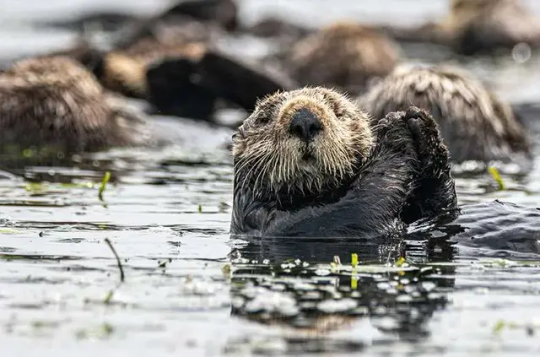
Adult otters need to eat around 25% of their body weight every day to endure the cold Pacific Ocean waters, the equivalent of 20 to 25 pounds. And crabs are one of their favorite meals. After three years, crab densities were 68% higher in fenced areas beyond the reach of otters. The number of crab burrows was also higher. At the same time, marsh grasses inside the fences fared worse, with 48% less mass of leaves and stems and 15% less root mass, a critical feature for capturing sediment that could otherwise wash away, the scientists reported in late January in Nature.
The results point to the crabs as a culprit in the decline of the marshes, as they excavate their holes and feed on the plant roots. It also shows the returning otters’ potential as a marsh savior, even in the face of rising sea levels and continued pollution. In tidal creeks with high numbers of otters, creek erosion was just 5 centimeters per year, 69% lower than in creeks with fewer otters and a far cry from earlier erosion of as much as 30 centimeters per year.
“The return of the sea otters didn’t reverse the losses, but it did slow them to a point that these systems could restabilize despite all the other pressures they are subject to,” said Brent Hughes, a biology professor at Sonoma State University and former postdoctoral researcher in Silliman’s Duke lab.
The findings raise the question of whether other coastal ecosystems might benefit from a return of top predators. The scientists note that a number of these places were once filled with such toothy creatures as bears, crocodiles, sharks, wolves, lions and dolphins. Sea otters are still largely absent along much of the West Coast.
As people wrestle to hold back the seas and revive their ailing coasts, a predator revival could offer relatively cheap and effective assistance. “It would cost millions of dollars for humans to rebuild these creek banks and restore these marshes,” Silliman said of Elk Slough. “The sea otters are stabilizing them for free in exchange for an all-you-can-eat crab feast.”"
-via Anthropocene Magazine, February 7, 2024
#otters#sea otters#conservation#erosion#coastal erosion#coastline#marshes#saltwater#marine science#marine biology#marine animals#sea creatures#ocean#sustainability#soil erosion#erosion control#crab#good news#hope
3K notes
·
View notes
Text
It was a jarring sight for more than one reason: plains bison darting from a cattle trailer onto long grass on land owned by the Louis Bull Tribe.
One by one, the 25 young animals sprung forcefully from the open back gate of the trailer and raced up a gentle hill toward the horizon on a cloudless Monday 90 kilometres south of Edmonton almost as though they’d done it before.
Except it was the first time in generations that bison had seen these homelands. It was the culmination of a four-year effort to reintroduce them to Maskwacis by the Louis Bull Tribe and Elk Island National Park.
Among the people watching the display was Louis Bull Tribe Chief Desmond Bull, who described the historic scene as one of mixed emotions.
“Pride, definitely. I felt a little bit of sadness, but honestly, a lot of hope,” Bull said. [...]
Continue Reading.
Tagging: @politicsofcanada, @abpoli, @vague-humanoid
#cdnpoli#Alberta#First Nations#Indigenous activism#conservation#flora & fauna#Maskwacis#Louis Bull Tribe
667 notes
·
View notes
Note


Elk Island National Park, Alberta, Canada
19 notes
·
View notes
Text

anyways elk island national park was really pretty
#supernatural#spn#isaac screams into the void#destiel#my roommate and I decided to go on an adventure and I infodumped to him about spn and destiel all night cuz he used to be an spn fan
19 notes
·
View notes
Text
Single frame: The Aurora on Friday night
45 degrees north, the latitude Portland is at, feels far enough north to regularly see the aurora borealis. But alas, sightings here are rare: The lights have to be strong and also it has to be clear, something that’s not easy to hope for during the winter months. The only time I had seen the aurora before this was on the Cross-Con Tour in 2011, when passing through Elk Island National Park just…

View On WordPress
2 notes
·
View notes
Text
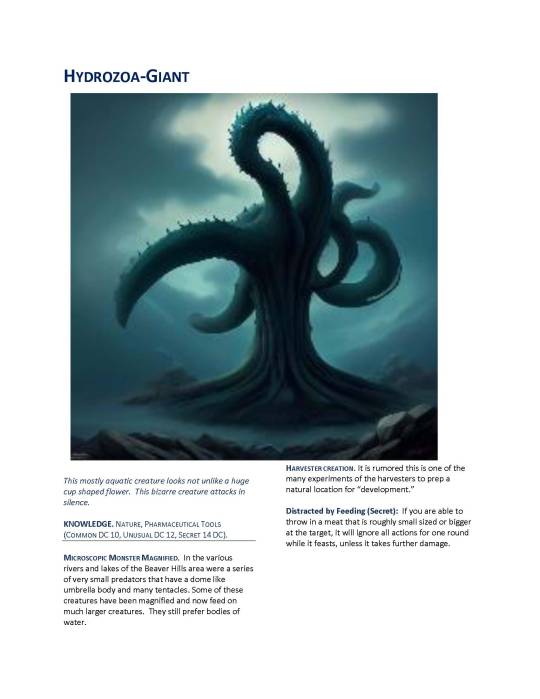

A long time ago, when I was a boy, I discovered the most terrifying creature in the depths of Astotin Lake at Elk Island National Park. So naturally, I make it gargantuan. Fear the Hydrozoa! #hodgepocalypse
6 notes
·
View notes
Text

Deercember Day Twenty-Nine: Barbary Stag | Lights
The Barbary stag (Cervus elaphus barbarus), also known as the Atlas deer or African elk, is a subspecies of the red deer that is native to North Africa. It is the only deer known to be native to Africa, aside from Megaceroides algericus, which went extinct approximately 6,000 years ago. Recent genetic studies indicate that the North African red deer population is practically indistinguishable from the Sardinian and Corsican populations, generally referred to as the Corsican red deer. This strongly argues for an ancient introduction of red deer from North Africa to these Mediterranean islands by humans. Further analysis suggests that the Barbary stag, including the Corsican red deer, belongs to a separate species, and should be grouped under the name Cervus corsicanus. The Barbary stag is smaller than the typical red deer. Its body is dark brown with some white spots on its flanks and back, and the antlers lack the bez (second) tine. It thrives in dense, humid forested areas of Algeria, Tunisia, and Morocco; it had initially been hunted to extinction in the latter, but specimens from the Tunisian population were reintroduced in the 1990s. One population can be found in Tazekka National Park in the Middle Atlas Mountains. Predators of the Barbary stag include, or included, the Barbary lion, the Atlas bear, the Barbary leopard, and the African wolf, but these have become either endangered or extinct in the regions where the Barbary stag occurs. More information here.
References: Deer, Background.
#as I did the smoke all I could think was “unhappy little clouds” and it's still cracking me up#since my location prompt did not include Africa#and there is distinctly and precisely one deer subspecies who currently lives there#you know I had to represent them#absolutely fascinated by the possibility of human introduction to islands prior to recorded history#or at least lost to time#Deercember#realHum#Art#Drawing#deer#deer art#Barbary stag#Atlas deer#African elk#Cervus elaphus barbarus#Cervus corsicanus
2 notes
·
View notes
Photo


Elk Island National Park, Alberta, gouache on paper 5x7″
the last painting from my winter 2022 collection!
#winter painting#landscape painting#landscape#winter landscape#landscape art#gouache#gouache painting#elk island#alberta#sky painting
12 notes
·
View notes
Text

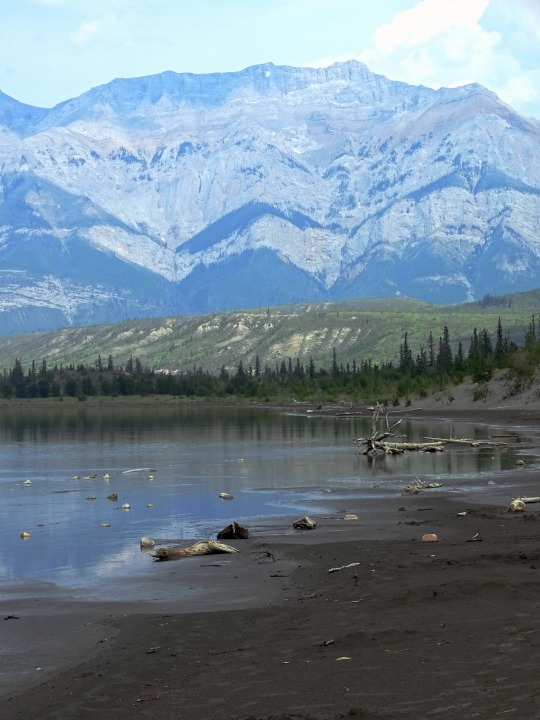

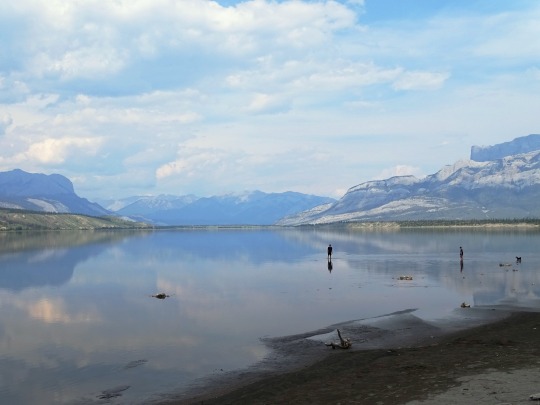
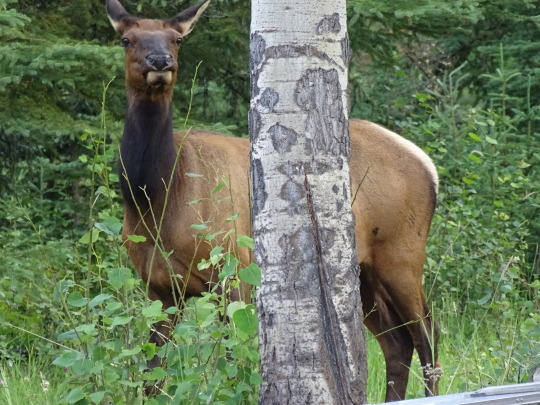
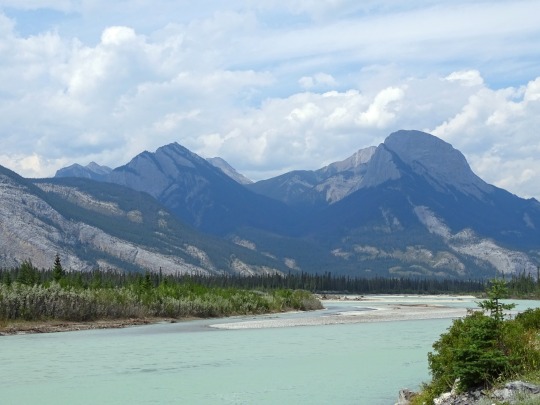


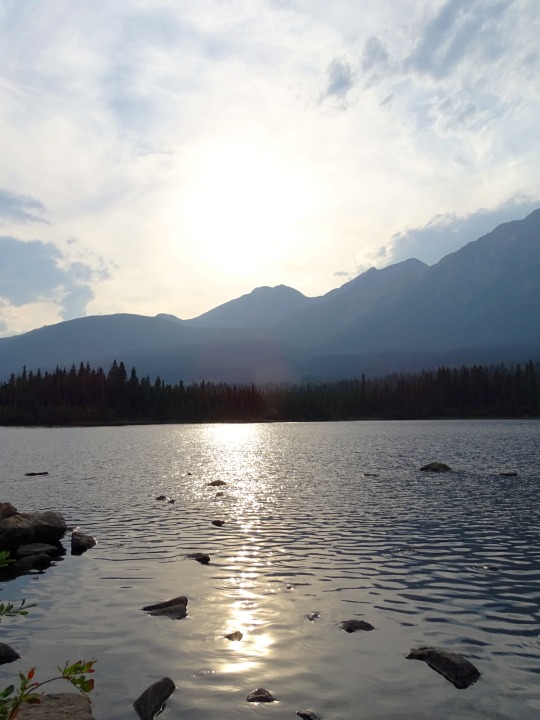

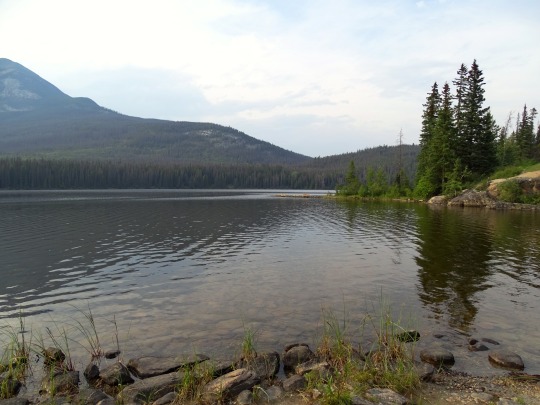
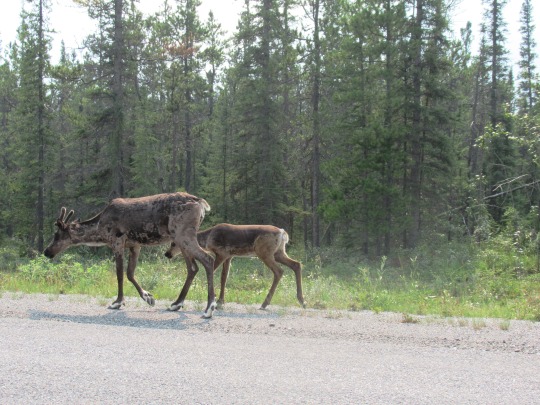

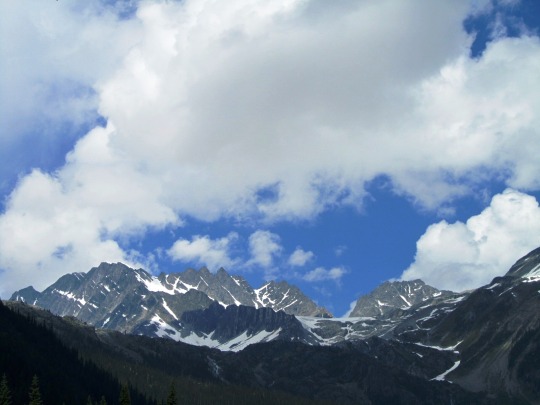

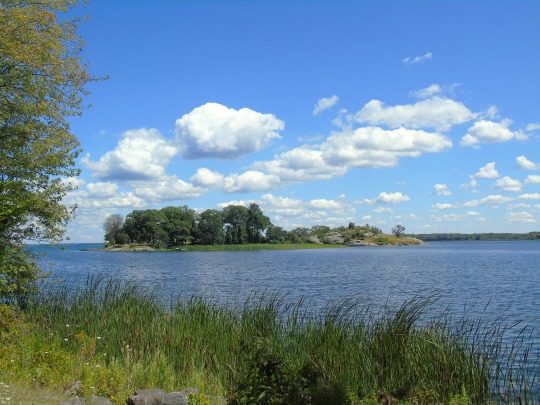
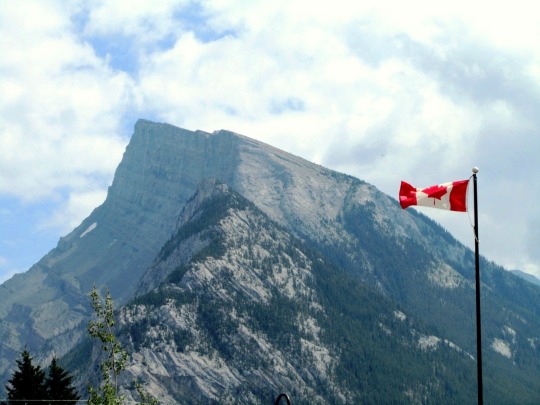






Parks Canada, the world’s first national park service, was established as the Dominion Parks Branch under the Department of the Interior on May 19, 1911.
#Terra Nova Nationalpark#Prince Edward Island National Park#landscape#countryside#original photography#travel#Yoho National Park#Banff National Park#Rocky Mountains#Lake Louise#Cascade Mountain#Parks Canada#established#19 May 1911#anniversary#Canadian history#Canada#Thousand Islands National Park#Cape Breton Highlands National Park#Rogers Pass#flora#forest#tourist attraction#landmark#vacation#Jasper National Park#elk#wood bison#caribou#wildlife
2 notes
·
View notes
Text
At Long Last, The American Buffalo Has Come Home
A conservation effort has returned bison to Blackfeet Nation tribal lands more than a century after the animal was nearly slaughtered to extinction.
— Photographs By Louise Johns | By Lailani Upham | Sunday July 09, 2023

“Nititawahsi” is the Blackfeet name for our land—the land where the iinnii (buffalo) live. Our people are Niitawahsin-nanni: the people of the land where the iinnii live.
As colonizers moved west, millions of buffalo were killed and brought to the edge of extinction. Millions more Native peoples were murdered, displaced, and forced to assimilate. By the end of the 19th century, only 300 buffalo were left in the wild and Native populations dropped to less than 300,000.
Now, after more than 150 years, iinnii have finally returned to their homeland, the Amskapi Pikuni (Blackfeet Nation) tribal lands, to roam free.

Forty-nine buffalo run out of their temporary enclosure towards Chief Mountain on the Blackfeet Reservation. The rest of the herd (about 70 buffalo) will join them at the end of the summer. Chief Mountain is not only prime buffalo habitat, but also a sacred place for Native people in both the U.S. and Canada.
“I can’t hardly describe the feeling that I have. I have this jittery feeling, goosebumps,” says Ervin Carlson, director of the Blackfeet Nation Buffalo Program. “It just feels so good to finally see them here in this place where we want them to be.”
On June 26, 49 iinnii were released into the wild at the base of our sacred Ninaistako (Chief Mountain), a Strong Miistaaki (Mountain) that stands tall like the warbonnets of Blackfeet warriors. This miistaaki towers along the border of the Blackfeet Nation, Glacier National Park in Montana, and Waterton National Park in Canada.
Our people, the Siksikaitsitapi (Blackfoot Confederacy) always believed the land we came from was a gift of the Creator, Ihtsi-pai-tapi-yopa. Our stories tell us that iinnii was created as a gift for our people as our life source. The iinnii were and still are our staff of life.
The iinnii coming back and being free on Blackfoot lands again is the beginning of reconciliation, says Cristina Mormorunni, director of Indigenous Led, the organization that leads cultural restoration and conservation of buffalo on Blackfoot lands. “This is the beginning of the truth being told about what happened, and they’re the best ambassadors,” she says.


Helen Augare, a Blackfeet knowledge keeper and director of the Blackfeet Community College Native Science Field Center, has been an integral voice in the return of buffalo to Chief Mountain for the past 15 years.
Now that the buffalo are free, she says “there’s so much still to reconnect to and learn from them.”
“What does that future look like and what [do] our children and grandchildren need to know to be able to help iinnii live a full and prosperous life with us again?” Augare says. “It entailed everything from healthy people, healthy land, healthy water, and most of all healthy relationships. That in itself requires a lot of healing, growth.”
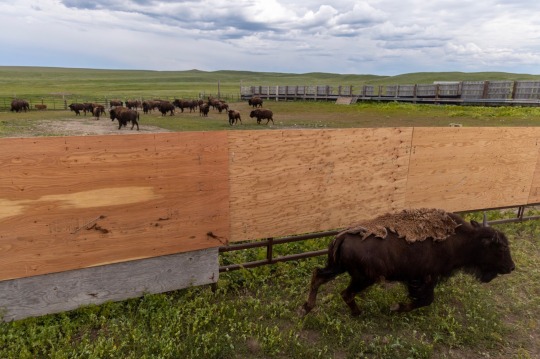
Buffalo are corralled and sorted (calves from adults, and males from females) at the tribal-owned Buffalo Spirit Hills Ranch on June 25, 2023. The herd, originally from Canada’s Elk Island National Park, have been living on the ranch since 2016. The herd descends from the last remaining wild buffalo before they were nearly extirpated.

Blackfeet tribal member Wyett Wippert takes a photo of his daughter, Ruby, in front of the buffalo in their soft release pen at Chief Mountain. “We put so much of our hearts into getting them here,” he says. “It’s a very good feeling knowing that they are under Chief Mountain. People know what they’re going to be doing for their environment and for us as Blackfeet people.” The buffalo are held here for several hours to settle into their surroundings before being released into the wild.

Racine, Monroe, and director Ervin Carlson of the Blackfeet Buffalo Program, on June 25, 2023, after a long day of preparing buffalo to be released at Chief Mountain. “It’s a lot of work to get these animals to this point… they are wild buffalo,” Racine says. “Nobody can do it by themselves. It’s a real honor to be able to have the Iinnii here and to be doing this.”
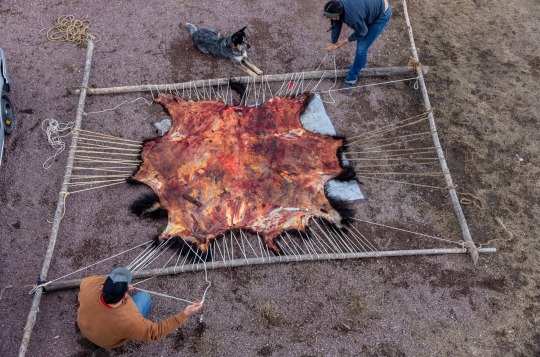
Blackfeet tribal members Wyett Wippert and Christen Falcon work together to stretch their bison hide onto their handmade wooden frame, the first step in tanning the hide by hand at their home in East Glacier, Montana. on April 9, 2023.

“Bison are a keystone species, they are ecosystem drivers and engineers. They were here for thousands of years,” says Brandon Kittson, wildlife biologist for Blackfeet Fish and Wildlife. “Now having them back on this landscape is a good thing. It’s going to help revitalize some systems and help drive diversity among the different vegetation and communities found in this area.”
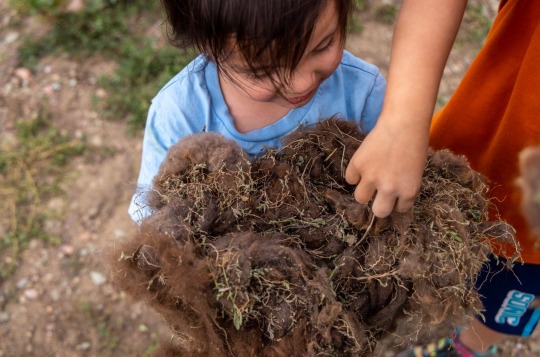
Children collect and examine clumps of buffalo fur from the corral at Buffalo Spirit Hills Ranch on June 25, 2023. The fur is integral to the health of the grassland ecosystem, as certain species of birds use it to line and insulate their nests.
— Photojournalist Louise Johns is a National Geographic Explorer. Her National Geographic Society-funded Project, "Buffalo Renaissance," is about Native American efforts to restore Bison to build cultural resiliency and ecological integrity.
#The National Geographic#American Buffalo#Photojournalist#Louise Johns#Buffalo Renaissance#Amskapi Pikuni (Blackfeet Nation)#Niitawahsin-Nanni#Chief Mountain#Ninaistako (Chief Mountain)#Glacier National Park in Montana#Waterton National Park in Canada#The Siksikaitsitapi (Blackfoot Confederacy)#Cristina Mormorunni#Helen Augare#Montana USA 🇺🇸#Canada 🇨🇦#Brandon Kittson Wildlife Biologist#National Geographic Explorer
5 notes
·
View notes
Text
zaterdag 9/12/2023
(deel 1)
Hallo iedereen. Snel even een update van de afgelopen maand, want ik zit momenteel in deadline seizoen! :(
Op 10 november ben ik op een nachtelijke trip gegaan naar Elk Island National park met Mei om sterren te spotten! De foto's zijn enorm wazig, maar geloof me, het uitzicht was prachtig. Ik heb nog nooit zoveel sterren gezien. Iemand had een gigantische telescoop mee, en zo hebben we Jupiter en Saturnus kunnen spotten. Ik heb zelfs de ringen rond Saturnus gezien! Jammer genoeg was het noorderlicht niet te zien.


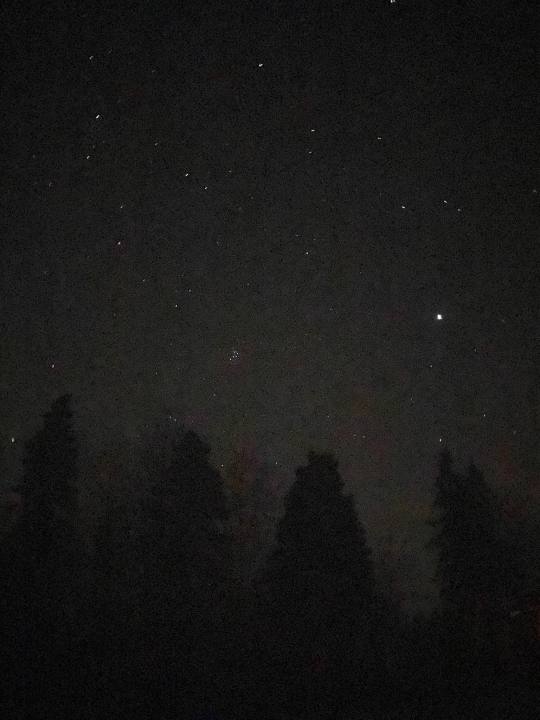
Tijdens reading week (een week vakantie in November), ben ik naar Calgary getrokken om een weekje bij Anna (mijn huisgenoot in Edmonton) en haar familie te blijven. Dinsdag ben ik naar de mall geweest (echt een ding hier) met Jin (onze andere huisgenoot die ook van Calgary is) en haar lief. s' Avonds zijn we gaan eten in een Koreanse BBQ plek. ZO lekker.




Woensdag ben ik Calgary stad gaan verkennen. Het bekendste monument van Calgary is de toren (zie foto's). Ik wou wel naar boven gaan, maar een ticket kostte 20 dollar........ Help. Anna's papa had vanalles opgeschreven dat ik zeker moest bekijken, dus ik heb zijn lijstje gevolgd. Mijn dag heb ik geeindigd in (weeral) een mall....






Sneeuw woensdagavond!!!! ft. Gypsy <3



Donderdag zijn Anna en ik naar Banff getrokken, op ongeveer een uurtje en half rijden van waar ze woont. Het was daar ongelooflijk prachtig. Ik raad iedereen aan om eens naar de parken van Alberta te gaan, want het is ongelooflijk. Het was wel super glad, omdat het net had gesneeuwd, en ik ben een paar keer net niet gevallen. Het stadje was ook super gezellig, met leuke restaurantjes en winkeltjes.
P.S.: spot de eekhoorn!








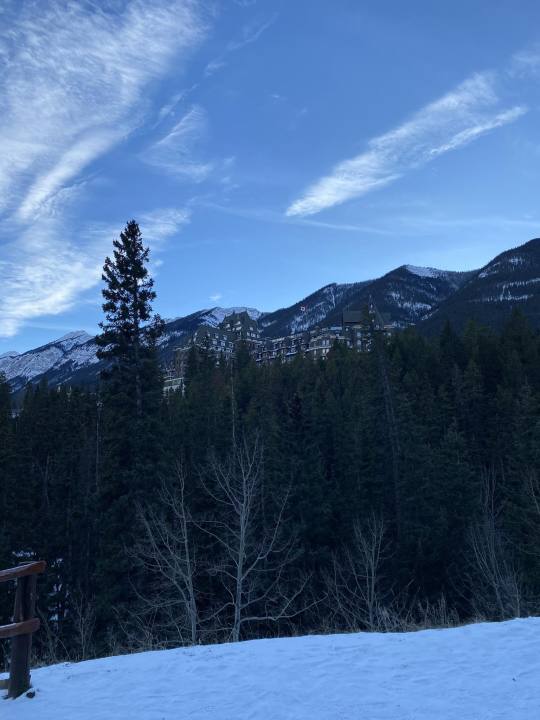
Op de terugweg zijn Anna en ik gestopt in Canmore, ook een super schattig stadje. Toen we daar waren, was er een van de mooise zonsondergangen, zeker met de bergen in de achtergrond <3
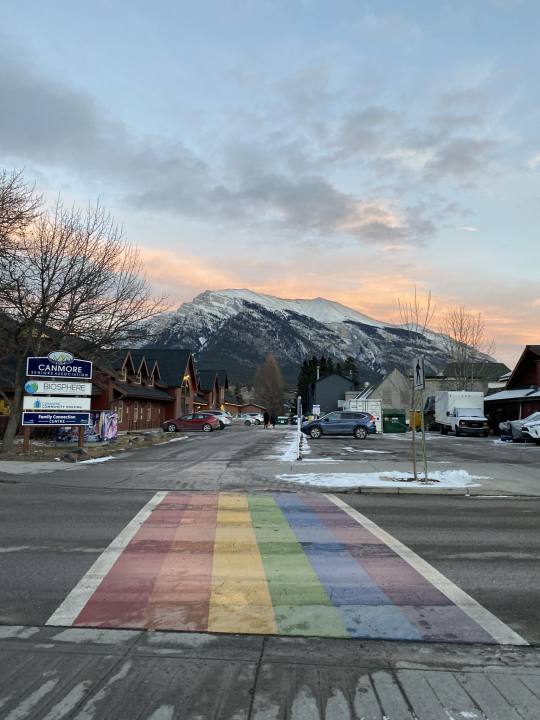
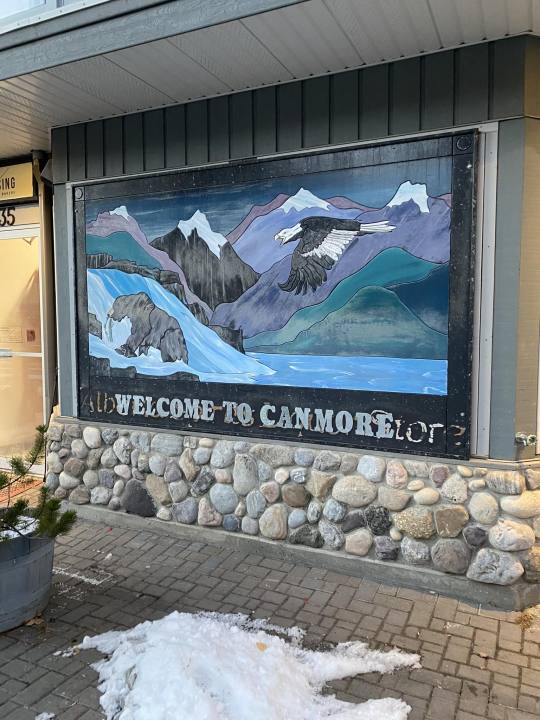

2 notes
·
View notes